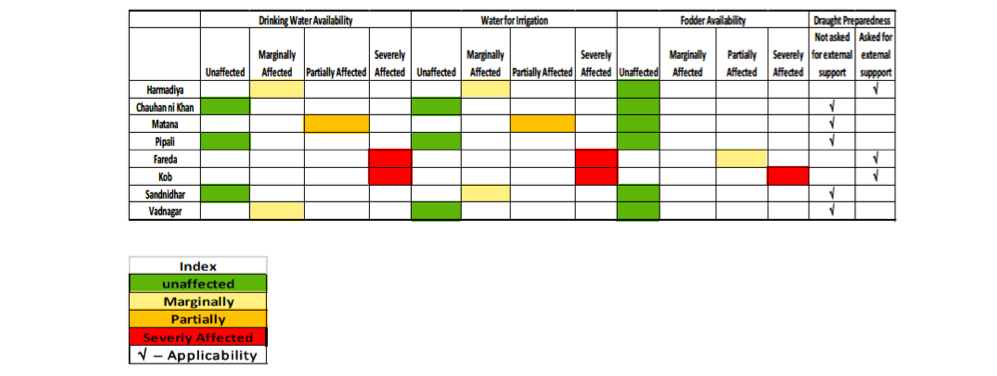The overall aim of Ambuja Foundation’s Water program is ‘to create 'drought-resilient' rural villages and ensure all-year-round water for farmers, families, and communities.’ It's a lofty claim. So how do we know that we are, in fact, achieving it?
To put our program aim to the test, Ambuja Foundation’s rigorous Monitoring & Research Unit, along with the engagement of outside consultants from time to time, point the microscope upon our work to understand what is working, what is not, and how we can do things better.
So a Situational Assessment of Water study conducted in the 2016 drought year, set out to measure exactly that – in a drought year, do Ambuja Foundation villages have an adequate supply of water for Drinking Water, Irrigation, and Fodder purposes, as compared to villages nearby that do not have Ambuja Foundation intervention?
How did we go about it
The internal rapid assessment was carried out via a series of Focus Group Discussions (FGDs) of 15-20 people from 4 Villages where Ambuja Foundation had initiated water interventions along with 2 ‘control’ villages from nearby, where Ambuja Foundation had not done any water work.
|
Ambuja Foundation Intervention Villages |
Control Villages |
|
Harmadiya |
Kob |
|
Chauhan ni Khan |
Fareda |
|
Matana |
|
|
Pipali |
|
|
Sandnidhar |
|
|
Vadnagar |
The primary objectives of the assessment were:
1. To assess water availability in the villages.
2. To review preparedness to face drought conditions if rain was further delayed.
3. To assess if Ambuja Foundation’s water program strategy needed any change.
Drinking Water Availability
Whilst most FGD interactions emphasized a reduced availability of water for drinking and domestic consumption, the study also showed that some villages did not indicate any scarcity of water at all. The Ambuja Foundation intervention villages of Chauhan ni khan, Pipli and Sandhnidhar reported zero water scarcity for drinking water, whereas Fareda, Kob (both control villages) indicated severe drinking water scarcity.
Kob village faced serious water constraints and resorted to buying drinking water from Larka and Tad villages. Funnily enough, both Larka and Tad happen to be Ambuja Foundation project villages with Ambuja Foundation intervention under the Coastal Area Development Project. People reported only 10% of water available in the village compared to the previous year. Different village segments depend on different sources of water and in the study year all the sources were stressed.
· Some sections have built RRWHS but the source of water is an issue and hence RRWHS does not get utilised.
· There was a government well at 1.5 km distance from the village which pumps water for 90 min. This water is enough for 10-12% of villagers (80-85 HHs).
· About 10% villagers (about 75HH) depend on a shallow drinking water well that had gone saline.
· The remaining villagers were reported to be paying for a private water tanker which is Rs.500/-a tanker of 5,000 litres
Fareda village faced serious drinking water issues also. The village pond fell dry just after the monsoon. 90% villagers reported to be arranging for drinking water from surrounding irrigation wells, which are located 1.5 km away. They mentioned that usually in summer they have tap connection supply for 1 hour a day, but that year, after March, there was no water supply at all. Whilst they found an alternative for drinking water in a couple of wells in the Gir forest and water using 200 ltr barrels in bullock cart or tractor to collect the water, it posed a serious risk to life of those who dared fetch it.
Based on the data gathered through FGDs, we understood that:
· Chauhan ni Khan, Pipli, and Sandnidhar were unaffected.
· Harmadiya and Vadnagar were marginally affected.
· Matana was partially affected.
· However the conditions is Fareda and Kob which were critical.
Water For Irrigation & Fodder
During the 2016 summer season all villages, except Pipli, mentioned a reduction in the area under irrigation for cultivation. There was a 5% reduction in cultivation in Chauhan ni Khan & Vadnagar, 10-15% reduction in Harmadiya and Sandnidhar to about 75% reduction in Fareda.
It is important to note that village Chauhan ni Khan, Vadnagar reported 95% land under irrigation and were growing a variety of crops. In the same region, however, Kob and Fareda village respectively had a mere 5% and 7% land under irrigation.
The data in the study also highlighted the performance of certain villages for fodder sufficiency. Though many villages had limited access to green fodder and were not certain about sustaining it, they had dry fodder as a backup. Fareda, despite having some quantities of dry fodder, did not see it is sufficient to last until monsoon. Kob was most affected where farmers had the liability of purchasing dry fodder.
The Results
The results can best be assessed via the graphic ‘Scorecard’ which was created upon analysis of the study data:
Fareda and Kob villages emerged as most vulnerable considering severe issues with drinking water availability and irrigation for cultivation. Kob is also marked severely affected with respect to fodder considering its total external dependence whereas Fareda has partially managed dry fodder stock.
On the other hand, the villages of Chauhan ni Khan and Pipli emerged as unaffected in all three aspects. Villages including Harmadiya, Vadnagar and Sandhnidhar highlighted marginal impact on drinking water and irrigation however they reported to be managing fodder well. Matana however faced an issue with its west side and hence emerged as partially affected in handling all three aspects. This insight helped Ambuja Foundation alter strategy and work to address this issue.
Ambuja Foundation water projects, which generated additional surface water storage area, supported an increase in water table levels which meant that these villages were less affected by the drought.
Fast Forward to 2021
Fast forward to 2021 and the villages of Harmadiya, Chauhan ni Khan, Matana, Pipali, Sandnidhar and Vadnagar continue to flourish thanks to abundant water. Continuous investment by Ambuja Foundation on drinking water distribution systems, water harvesting and the introduction of drip irrigation to help farmers save water, has further strengthened their resilience to any drought in future.
Additionally, the 2016 study helped Ambuja Foundation identify gaps to address. For Example, in 2016, In Vadnagar village there was one hamlet on the outskirts of the village which still did not have access to drinking water supply. In the following year, Ambuja Foundation worked on this gap and ensured 100% household coverage for drinking water in the hamlet and wider community.
Lastly, in all six villages, people are well aware of the efficient use of water and have people’s institutions set up in each village to manage the sources created. In this way, the people have taken control in managing this precious resource for the betterment of the community – and its sustainability.
In Conclusion
The correlation between the water resource work done by Ambuja Foundation, and the drought resilience of those villages during the 2016 drought was best summed up by the locals themselves. Arsibhai Govindbhai Chavada of Sandhnidhar village said:
“Due to deepening of the pond near the forest area and check dam constructed on the river, the water table has increased. We also have one drinking water bore well near the Ambuja Foundation-constructed pond. Even now, at this critical time, 24 hours of water is available in this bore. This has happened only due to the pond and check dam constructed by Ambuja Foundation. As a result, we never need or invite water tankers into our village.”








